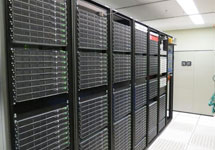

First opened to users in January 2008, the Hoffman2 Shared Research Cluster is an IDRE project that serves thousands of members of the UCLA research community, allowing researchers to run multi-level simulations, do complex data analysis and perform large-scale computations.
Eleazar Eskin, a professor in the departments of computer science and human genetics at UCLA, is one of the Hoffman2 Cluster’s biggest users and strongest advocates. The Hoffman2 Cluster has proven to be an invaluable resource in his bioinformatics and computational genetics research.
When he first started his Ph.D. program, Eskin was interested in “machine learning,” now more commonly referred to as big data analysis. But with the announcement of the human genome completion in 2000, Eskin’s interests shifted. During this time, “I got into computational biology, and one of the projects we were working on was genetic analysis and variation. Within a few years, that is what I decided to focus on,” said Eskin.
Today Eskin’s research focuses on “the analysis of human genetic variation data, which is understanding the relationship between genetic variation and traits.” Those interested in the genetic basis of complex traits seek to comprehend how genetics are significant to particular diseases, behaviors and appearances. By analyzing human genetic variation data, researchers can begin to “understand why certain people are at a higher risk for a particular disease and others are not,” Eskin stated.
In large studies known as genome-wide association studies, researchers “study hundreds of thousands of individuals who have a certain disease and compare them to individuals who don’t have that disease. Then researchers look for genetic variation between the groups,” said Eskin. His group then develops statistical algorithms and methods for how to analyze the kind of data produced by these large studies.
Currently, Eskin’s research team is occupied with several interesting projects. “One of our main focuses is understanding how genetics interacts with the environment. We’re looking at some diet-related stuff and seeing how genetic variation makes some people respond one way to a high fat diet and others to not respond to a high fat diet,” said Eskin.
His group is also working on a project to identify a person’s ancestry using their genetics. He noted, “Every student in the lab works on several different projects all related to understanding the relationship between genetic variation and traits.”
Eskin was quick to identify the Hoffman2 Cluster as the most beneficial resource available to him at UCLA. “The Hoffman2 Cluster really plays two major roles … One aspect is that we use the Hoffman2 Cluster for research in general. The second aspect is that it enables collaboration between different research groups,” stated Eskin.
On the research end, the Hoffman2 Cluster allows Eskin to run large data sets, complete extensive computations and do large-scale simulations to test his methods.
The Hoffman2 Cluster is also conducive to cooperation between research teams. “We are just one small group within the UCLA bioinformatics community, but we have a shared research group on Hoffman. The nice thing about Hoffman is that, since we’re all using the same system, it’s really easy to collaborate,” said Eskin.
Eskin has been very successful in getting a team together to form the largest research group on the Hoffman2 Cluster. Members of the “Eskin Group” pool funds so they can buy more storage space, run large simulations, or run many smaller simulations concurrently.
Eskin advises others to join groups on the Cluster instead of buying their own since it is more cost-effective, and he compliments IDRE’s openness, which has facilitated collaboration between researchers across various departments.
“It is cheaper for people to join [a] group rather than to buy their own systems independently. Over the years, groups have invested over one million dollars of computational resources into Hoffman, which is probably 10 times more the initial campus investment we got to start our group in the cluster. I think the key thing is that we have a collaborative spirit in our group that makes things work well together. Also IDRE is very open and has an executive committee that is open. Many people in our group are now part of the committee and are constantly working on how to manage the cluster. So overall it’s a good environment for getting groups to collaborate,” he said.